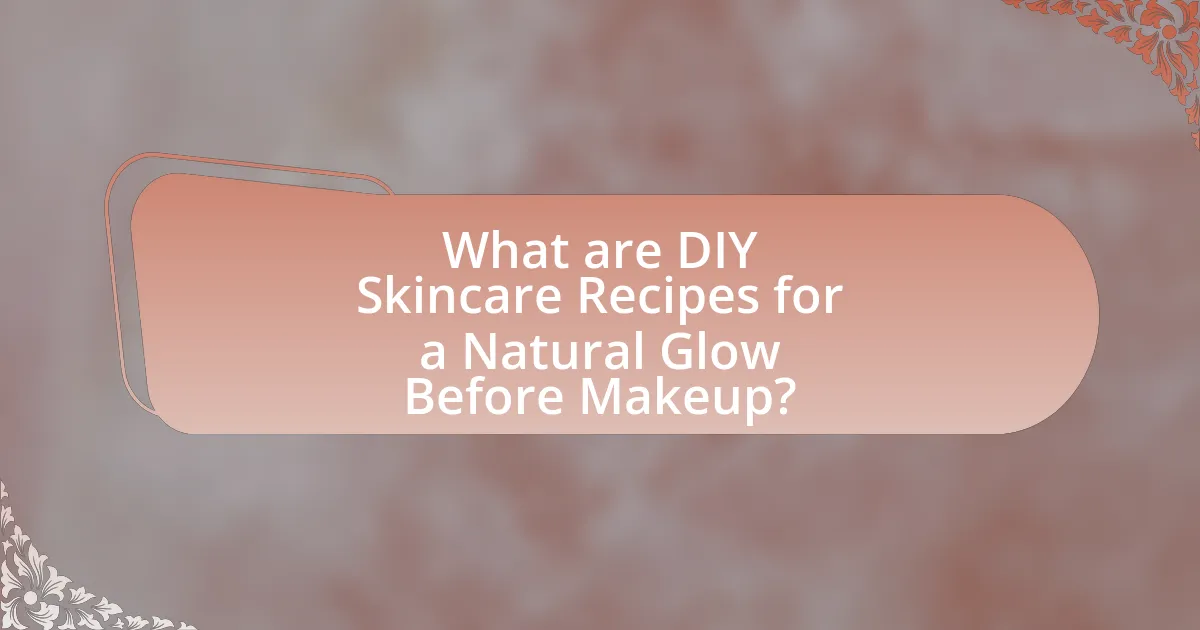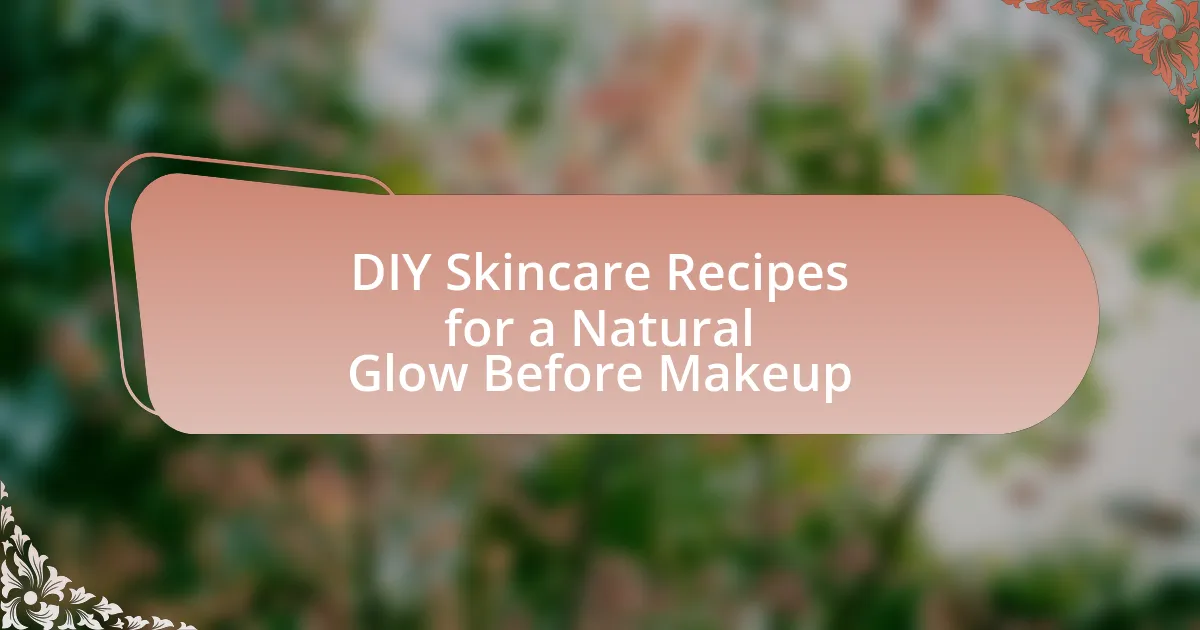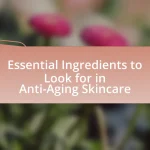DIY skincare recipes for achieving a natural glow before makeup focus on using simple, natural ingredients that enhance skin radiance. Key recipes include a honey and lemon mask for brightening, a yogurt and turmeric scrub for exfoliation, and an avocado and olive oil moisturizer for hydration. The article explores how these ingredients, such as aloe vera, coconut oil, and essential oils, contribute to skin health and luminosity while allowing customization for different skin types. Additionally, it highlights the benefits of choosing DIY skincare over commercial products, emphasizing the effectiveness and safety of natural ingredients. Best practices for application, troubleshooting common issues, and optimal usage frequency are also discussed to ensure successful results.

What are DIY Skincare Recipes for a Natural Glow Before Makeup?
DIY skincare recipes for a natural glow before makeup include a honey and lemon mask, a yogurt and turmeric scrub, and an avocado and olive oil moisturizer. The honey and lemon mask combines one tablespoon of honey with the juice of half a lemon, which brightens the skin due to honey’s antibacterial properties and lemon’s vitamin C content. The yogurt and turmeric scrub consists of two tablespoons of yogurt mixed with a pinch of turmeric, providing exfoliation and anti-inflammatory benefits. Lastly, the avocado and olive oil moisturizer, made by mashing half an avocado and mixing it with one tablespoon of olive oil, hydrates and nourishes the skin, enhancing its natural radiance. These recipes utilize natural ingredients known for their skin benefits, promoting a healthy glow before applying makeup.
How do DIY skincare recipes enhance skin radiance?
DIY skincare recipes enhance skin radiance by utilizing natural ingredients that nourish and rejuvenate the skin. These recipes often include components like honey, which is known for its moisturizing and antibacterial properties, and vitamin C-rich fruits such as citrus, which can brighten the complexion. Studies have shown that ingredients like aloe vera and coconut oil can improve skin hydration and elasticity, contributing to a more radiant appearance. Furthermore, the absence of harsh chemicals in DIY recipes minimizes irritation, allowing the skin to maintain its natural glow.
What ingredients are commonly used in these recipes?
Common ingredients used in DIY skincare recipes for a natural glow before makeup include aloe vera, coconut oil, honey, and essential oils. Aloe vera is known for its soothing properties and hydration benefits, while coconut oil acts as a moisturizer and has antibacterial qualities. Honey is often used for its natural humectant properties, helping to retain moisture in the skin. Essential oils, such as lavender or tea tree oil, are frequently added for their aromatic benefits and skin-enhancing properties. These ingredients are widely recognized in skincare for their effectiveness and natural origins.
How do these ingredients contribute to a natural glow?
Certain ingredients contribute to a natural glow by enhancing skin hydration, promoting cell turnover, and providing antioxidant protection. For instance, ingredients like hyaluronic acid attract moisture to the skin, resulting in a plump and dewy appearance. Vitamin C, known for its brightening properties, helps to even skin tone and reduce dark spots, thereby enhancing radiance. Additionally, natural oils such as jojoba or argan oil nourish the skin and create a protective barrier, locking in moisture and imparting a healthy sheen. These effects are supported by studies showing that hydration and antioxidant-rich compounds significantly improve skin texture and luminosity.
Why choose DIY skincare over commercial products?
Choosing DIY skincare over commercial products allows for greater control over ingredients, ensuring they are natural and free from harmful chemicals. Many commercial skincare products contain synthetic additives, preservatives, and fragrances that can irritate the skin or cause allergic reactions. In contrast, DIY skincare utilizes readily available natural ingredients, such as oils, herbs, and fruits, which can be tailored to individual skin types and concerns. Research indicates that natural ingredients like aloe vera and coconut oil have beneficial properties for skin health, supporting the effectiveness of DIY formulations. Additionally, DIY skincare often proves to be more cost-effective, as it allows individuals to create multiple products from a few basic ingredients, reducing overall spending on skincare.
What are the benefits of using natural ingredients?
Using natural ingredients in skincare offers numerous benefits, including reduced risk of irritation and enhanced skin health. Natural ingredients, such as aloe vera and coconut oil, are less likely to contain synthetic chemicals that can cause allergic reactions or skin sensitivities. Studies indicate that natural compounds often possess beneficial properties, such as antioxidants and anti-inflammatory effects, which can improve skin texture and appearance. For instance, a study published in the Journal of Cosmetic Dermatology found that products containing natural extracts significantly improved skin hydration and elasticity compared to synthetic alternatives.
How can DIY recipes be customized for different skin types?
DIY recipes can be customized for different skin types by selecting ingredients that address specific skin concerns. For oily skin, recipes can include ingredients like clay or tea tree oil, which help absorb excess oil and reduce acne. For dry skin, incorporating moisturizing elements such as honey, avocado, or coconut oil can provide hydration and nourishment. Sensitive skin can benefit from soothing ingredients like aloe vera or chamomile, which reduce irritation. Each skin type has unique needs, and tailoring recipes with appropriate ingredients ensures effectiveness and safety for individual skin conditions.
What are some popular DIY skincare recipes for a natural glow?
Some popular DIY skincare recipes for a natural glow include a honey and lemon mask, a coffee scrub, and an avocado face mask. The honey and lemon mask combines the antibacterial properties of honey with the brightening effects of lemon juice, promoting a radiant complexion. The coffee scrub utilizes caffeine to enhance circulation and exfoliate dead skin cells, resulting in smoother skin. The avocado face mask, rich in healthy fats and vitamins, deeply moisturizes and nourishes the skin, contributing to a healthy glow. These recipes are widely recognized for their effectiveness in enhancing skin radiance and are easy to prepare at home.
How do you make a honey and lemon face mask?
To make a honey and lemon face mask, combine two tablespoons of honey with one tablespoon of freshly squeezed lemon juice in a bowl. Honey acts as a natural moisturizer and has antibacterial properties, while lemon juice contains vitamin C and can help brighten the skin. Mix the ingredients thoroughly until well blended, then apply the mixture evenly to your face, avoiding the eye area. Leave the mask on for about 15-20 minutes before rinsing it off with warm water. This combination is known for its skin benefits, including hydration and brightening effects.
What is the process for creating a coconut oil scrub?
To create a coconut oil scrub, combine equal parts of coconut oil and a granular exfoliant, such as sugar or salt. First, melt the coconut oil if it is solid, then mix it thoroughly with the exfoliant until a consistent texture is achieved. This mixture can be enhanced with optional ingredients like essential oils for fragrance or additional skin benefits. The scrub can be used immediately or stored in an airtight container for future use. Coconut oil is known for its moisturizing properties, while the exfoliant helps remove dead skin cells, promoting a smoother and more radiant complexion.
How can you prepare your skin before applying makeup?
To prepare your skin before applying makeup, cleanse, exfoliate, and moisturize. Cleansing removes dirt and oil, ensuring a clean canvas for makeup application. Exfoliating eliminates dead skin cells, promoting a smoother texture and better makeup adherence. Moisturizing hydrates the skin, creating a plump surface that enhances makeup longevity. According to dermatological studies, properly prepped skin can improve makeup wear time by up to 50%, demonstrating the importance of these steps in achieving a flawless look.
What are the best practices for applying DIY skincare products?
The best practices for applying DIY skincare products include ensuring skin is clean and dry before application, using fresh ingredients to avoid contamination, and performing a patch test to check for allergic reactions. Clean skin allows for better absorption of the product, while fresh ingredients minimize the risk of irritation or infection. A patch test, typically done on a small area of skin, helps identify any adverse reactions before applying the product more broadly. These practices enhance the effectiveness of DIY skincare and promote skin health.

What specific ingredients should be included in DIY skincare recipes?
DIY skincare recipes should include ingredients such as aloe vera, coconut oil, honey, shea butter, and essential oils. Aloe vera is known for its soothing properties and hydration benefits, making it ideal for skin preparation. Coconut oil serves as an excellent moisturizer and has antibacterial properties. Honey acts as a natural humectant, drawing moisture into the skin, while shea butter provides deep nourishment and helps with skin elasticity. Essential oils, like lavender or tea tree, can offer additional benefits such as calming effects or acne treatment. These ingredients are widely recognized in skincare formulations for their effectiveness and safety.
How do essential oils enhance DIY skincare recipes?
Essential oils enhance DIY skincare recipes by providing therapeutic benefits, natural fragrances, and skin-nourishing properties. These concentrated plant extracts can improve skin conditions such as acne, dryness, and aging due to their antibacterial, anti-inflammatory, and antioxidant properties. For example, tea tree oil is known for its effectiveness against acne due to its antibacterial qualities, while lavender oil can soothe irritated skin and promote relaxation. Additionally, essential oils can elevate the sensory experience of skincare products, making them more enjoyable to use, which can encourage consistent skincare routines.
Which essential oils are best for glowing skin?
The essential oils best for glowing skin include lavender oil, tea tree oil, frankincense oil, and rose oil. Lavender oil is known for its calming properties and ability to promote skin healing, which can enhance skin radiance. Tea tree oil possesses antibacterial properties that help clear blemishes, contributing to a clearer complexion. Frankincense oil is recognized for its ability to reduce the appearance of scars and improve skin tone, while rose oil is celebrated for its hydrating and soothing effects, promoting a healthy glow. These oils are often used in skincare formulations due to their proven benefits in enhancing skin appearance and health.
How can essential oils be safely incorporated into recipes?
Essential oils can be safely incorporated into recipes by using them in small, controlled amounts, typically one drop per teaspoon of carrier oil or other base ingredients. This dilution minimizes the risk of skin irritation and ensures that the essential oils do not overpower the other ingredients. For example, when creating a DIY skincare recipe, combining one drop of lavender essential oil with a tablespoon of coconut oil provides both fragrance and therapeutic benefits without compromising safety. Additionally, it is crucial to choose high-quality, food-grade essential oils, as some oils may contain additives that are not safe for topical use.
What natural exfoliants can be used in DIY recipes?
Natural exfoliants that can be used in DIY recipes include sugar, coffee grounds, oatmeal, and sea salt. Sugar is effective due to its granules that help slough off dead skin cells, while coffee grounds provide a stimulating effect and can improve circulation. Oatmeal is gentle and soothing, making it suitable for sensitive skin, and sea salt offers mineral benefits along with exfoliation. These ingredients are commonly found in many DIY skincare recipes, enhancing skin texture and promoting a natural glow.
How does sugar compare to salt as an exfoliant?
Sugar is generally considered a gentler exfoliant compared to salt. Sugar granules are smaller and rounder, which allows for a milder scrubbing action that is less likely to irritate the skin. In contrast, salt has sharper edges and can be more abrasive, potentially causing micro-tears in sensitive skin. Studies indicate that sugar can also provide additional benefits, such as hydration, due to its natural humectant properties, which help retain moisture in the skin. This makes sugar a preferred choice for those seeking a more soothing exfoliation experience.
What are the benefits of using oatmeal in skincare?
Oatmeal provides multiple benefits for skincare, including its ability to soothe irritation, moisturize the skin, and act as a gentle exfoliant. The anti-inflammatory properties of oatmeal help reduce redness and calm conditions like eczema and psoriasis, making it ideal for sensitive skin. Additionally, oatmeal contains beta-glucans, which enhance skin hydration by forming a protective barrier that retains moisture. Its saponins offer mild cleansing properties, effectively removing dirt and oil without stripping the skin of its natural oils. Studies have shown that colloidal oatmeal can significantly improve skin hydration and barrier function, as evidenced by research published in the Journal of Drugs in Dermatology, which highlights its effectiveness in treating dry skin conditions.

How can you troubleshoot common issues with DIY skincare recipes?
To troubleshoot common issues with DIY skincare recipes, first identify the specific problem, such as separation, irritation, or ineffective results. For instance, if a mixture separates, ensure that emulsifiers are used correctly, as they help blend oil and water-based ingredients. If irritation occurs, check for allergens or overly potent ingredients; patch testing can prevent adverse reactions. For ineffective results, assess ingredient quality and freshness, as expired or low-quality components can diminish effectiveness. These troubleshooting steps are supported by the fact that proper formulation and ingredient selection are crucial for achieving desired skincare outcomes.
What should you do if a recipe irritates your skin?
If a recipe irritates your skin, immediately discontinue use and rinse the affected area with cool water to remove any residue. This action helps to soothe the skin and reduce irritation. Following this, apply a gentle moisturizer or aloe vera gel to calm the skin. If irritation persists or worsens, consult a healthcare professional for further evaluation and treatment.
How can you adjust recipes for sensitive skin?
To adjust recipes for sensitive skin, use gentle, hypoallergenic ingredients that minimize irritation. For example, replace common irritants like essential oils and fragrances with soothing alternatives such as aloe vera or chamomile. Studies show that ingredients like oatmeal and honey have anti-inflammatory properties, making them suitable for sensitive skin. Additionally, always conduct a patch test before applying new formulations to ensure compatibility with sensitive skin.
What tips can help you achieve the best results with DIY skincare?
To achieve the best results with DIY skincare, prioritize using high-quality, natural ingredients tailored to your skin type. Selecting ingredients such as honey for hydration, aloe vera for soothing, and coconut oil for moisture can enhance the effectiveness of your skincare routine. Additionally, ensure proper sanitation by sterilizing tools and containers to prevent contamination, which is crucial for maintaining skin health. Consistency in application is also vital; regular use of DIY products can lead to noticeable improvements in skin texture and appearance. Studies indicate that natural ingredients can provide beneficial effects, such as improved hydration and reduced irritation, supporting the efficacy of DIY skincare practices.
How often should you use DIY skincare recipes for optimal glow?
For optimal glow, you should use DIY skincare recipes 2 to 3 times a week. This frequency allows the skin to benefit from the natural ingredients without overwhelming it, as overuse can lead to irritation or sensitivity. Studies indicate that regular application of natural ingredients, such as honey or aloe vera, can enhance skin hydration and radiance, contributing to a healthier appearance.
What storage methods are best for homemade skincare products?
The best storage methods for homemade skincare products include using airtight containers, refrigeration, and dark glass bottles. Airtight containers prevent contamination and moisture, which can spoil the products. Refrigeration extends the shelf life of products, especially those containing perishable ingredients like oils or fresh botanicals. Dark glass bottles protect sensitive ingredients from light exposure, which can degrade their effectiveness. These methods are supported by the fact that proper storage can significantly reduce the risk of microbial growth and oxidation, ensuring the safety and efficacy of homemade skincare formulations.


